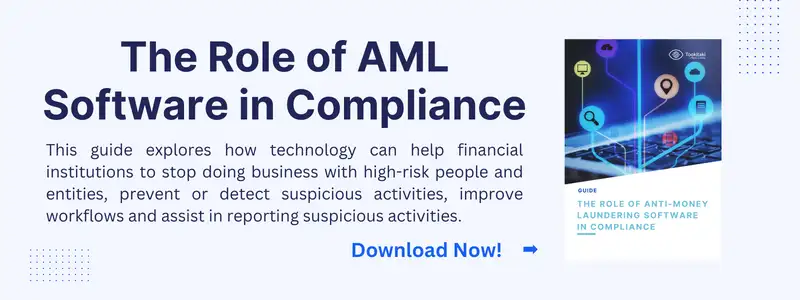In the ever-evolving landscape of financial regulations, Anti-Money Laundering (AML) compliance remains a cornerstone of integrity for institutions worldwide. Amidst diverse client portfolios and complex global transactions, a one-size-fits-all compliance strategy is no longer viable. Herein lies the significance of a risk-based approach to AML (RBA), a dynamic and adaptive strategy empowering institutions to allocate their resources effectively, aligning with the level of risk associated with their clients and transactions.
This article delves into the mechanics of RBA, illustrating its practical application, fundamental components, and the transformative power of transaction monitoring tools in fortifying AML defences.
Risk-Based Approach for AML Compliance
The risk-based approach for AML compliance signifies a shift from traditional, rule-based strategies, demanding institutions to be proactive rather than reactive. It necessitates the identification, assessment, and understanding of potential money laundering and terrorist financing risks specific to an institution, followed by the implementation of controls proportionate to those risks. This approach, endorsed globally by bodies like the Financial Action Task Force (FATF), allows institutions to optimize their compliance efforts and resources where they are most needed, especially in higher-risk areas, without overburdening areas with lower-risk profiles.
How Does a Risk-Based Approach Work?
The risk-based approach isn't a mere procedural change; it's a shift in mindset. It begins with a comprehensive risk assessment, where institutions evaluate their exposure to potential AML risks. This involves analyzing various factors such as customer types, transaction patterns, service offerings, and geographic locations. Post-assessment, institutions categorise these risks into levels (low, medium, high) and tailor their control measures accordingly. Enhanced due diligence is conducted for higher-risk categories, while simplified measures may suffice for lower-risk ones. The approach demands continuous monitoring and periodic reassessment of risks, ensuring an agile and up-to-date compliance program.
Risk-Based Approach Examples
In practice, the risk-based approach manifests in scenarios like enhanced scrutiny for high-net-worth individuals, politically exposed persons (PEPs), or transactions involving high-risk jurisdictions. Conversely, a local retail business making small, frequent deposits might not necessitate stringent monitoring. Another example is the adoption of advanced transaction monitoring tools that flag anomalies in real time, enabling immediate investigation and action, a tactic especially relevant in high-risk scenarios.
Main Elements of a Risk-Based Approach
The efficacy of a risk-based approach hinges on several key elements, each a cog in a well-oiled machine:
- Risk Identification: The first step involves casting a wide net to capture all possible AML risks that an institution might face. This includes risks associated with customers, countries or geographic areas, products, services, transactions, or delivery channels.
- Risk Assessment: Once identified, each risk must be assessed for its severity and likelihood. This process should consider all relevant information, such as negative news media, sanction lists, and transaction behavior, to determine the potential impact and probability of each risk.
- Risk Mitigation: After assessment, institutions need to apply risk mitigation measures. This means implementing controls designed to reduce the risks to acceptable levels. These controls can range from customer due diligence measures to transaction monitoring and reporting systems.
- Risk Review: The financial landscape is ever-changing, and so are its associated risks. Regular reviews and updates to the risk assessment are vital to ensure that the risk-based approach stays relevant and effective.
- Risk Reporting: A clear line of communication is essential in the risk-based approach. Relevant stakeholders, both internal and regulatory bodies, should be kept informed of risk findings, mitigation efforts, and strategic changes.
Risk Assessment in the Risk-Based Approach
Risk assessment serves as the cornerstone of the risk-based approach, providing a systematic and thorough evaluation of the potential money laundering and terrorist financing risks that an institution may encounter. It involves a deep dive into:
- Customer Risk: Not all customers pose the same level of risk. Institutions need to assess the risk level of each customer, considering factors like occupation, income source, transaction behaviour, and geographic location.
- Product, Service, and Transaction Risk: Certain products and services carry higher AML risk, especially those that involve high-value transactions or anonymity. These require a more thorough risk assessment.
- Geographic Risk: Transactions originating from or destined for countries with high levels of corruption, ongoing conflict, or inadequate AML regulations demand heightened attention.
- Delivery Channel Risk: The way services are delivered can also affect risk. Non-face-to-face business relationships or transactions are typically riskier than traditional channels.
Transaction Monitoring Tool for Risk-Based Approach
In the digital age, transaction monitoring tools are the sentinels in the fight against financial crime. These systems, equipped with advanced analytics, machine learning, and artificial intelligence, can sift through millions of transactions, identifying patterns and anomalies that might suggest suspicious activity.
They are configurable to an institution's risk appetite, ensuring that monitoring efforts align with the risk-based approach. By automating what would otherwise be a resource-intensive process, these tools not only enhance detection rates but also improve operational efficiency and compliance adherence.
The Importance of a Risk-Based Approach in AML Compliance
Adopting a risk-based approach to AML compliance isn't just a regulatory requirement; it's a strategic imperative. Here's why:
- Proactive Risk Management: Instead of a one-size-fits-all solution, a risk-based approach allows institutions to allocate their resources efficiently and effectively, targeting areas of higher risk and ensuring that potential threats are identified and managed proactively.
- Regulatory Compliance: With regulators worldwide endorsing the risk-based approach, its implementation is key to complying with domestic and international AML laws and guidelines, thereby avoiding potential sanctions, fines, and reputational damage.
- Operational Efficiency: By prioritizing efforts where they're most needed, institutions can optimize their use of resources, saving time, and money while maintaining robust AML controls.
- Customer Trust: A sound risk-based approach helps protect institutions from being exploited for illicit purposes, thereby increasing trust among customers, stakeholders, and the wider community.
- Dynamic Adaptation: The financial sector is fast-evolving, with new products, services, and delivery methods emerging regularly. A risk-based approach allows for the flexibility and adaptability needed to manage new risks effectively as they arise.
Tookitaki's Innovative Approach to Achieving A Risk-Based AML Strategy
Tookitaki empowers financial institutions to adopt a risk-based approach to Anti-Money Laundering (AML) through its cutting-edge solutions and expertise. Here's how:
- Advanced Screening Techniques: Tookitaki's Smart Screening solutions utilize AI and machine learning to enhance customer due diligence and transaction monitoring. By employing a dynamic risk scoring system, institutions can prioritize high-risk entities and activities, focusing their resources where they matter most.
- Advanced Monitoring: Tookitaki's technology enables real-time monitoring of customer behavior and transaction patterns. This constant vigilance ensures that any deviations from expected norms are promptly flagged, allowing institutions to respond swiftly to emerging risks.
- Customized Risk Models: Institutions can tailor risk models to their specific needs. Whether it's adapting to new regulations, assessing the risk associated with different customer segments, or considering geographic factors, Tookitaki's solutions are flexible and adaptable.
- Reduced False Positives: By reducing false positives through precise screening, Tookitaki minimizes the strain on compliance teams. Institutions can allocate their resources efficiently, focusing on genuine threats rather than sifting through irrelevant alerts.
- Enhanced Regulatory Compliance: With Tookitaki's support, institutions can strengthen their AML programs to meet regulatory requirements effectively. This proactive approach not only reduces the risk of fines but also builds a robust compliance culture.
Tookitaki's innovative technology and commitment to a risk-based approach in AML provide financial institutions with the tools needed to safeguard against money laundering while optimising operational efficiency.
Final Thoughts
In the battle against money laundering and terrorist financing, a risk-based approach is the sharpest weapon financial institutions have. It enables them to understand the complexity and diversity of risks they face and to apply their resources in a manner that is commensurate with those risks. By focusing on areas of higher risk, institutions can strengthen their defences against financial crime, ensure regulatory compliance, and foster a safer, more trustworthy financial environment.
However, it's important to remember that a risk-based approach is not a set-and-forget solution. It requires ongoing commitment, regular updates, and a deep understanding of the ever-evolving risk landscape.
Anti-Financial Crime Compliance with Tookitaki?




